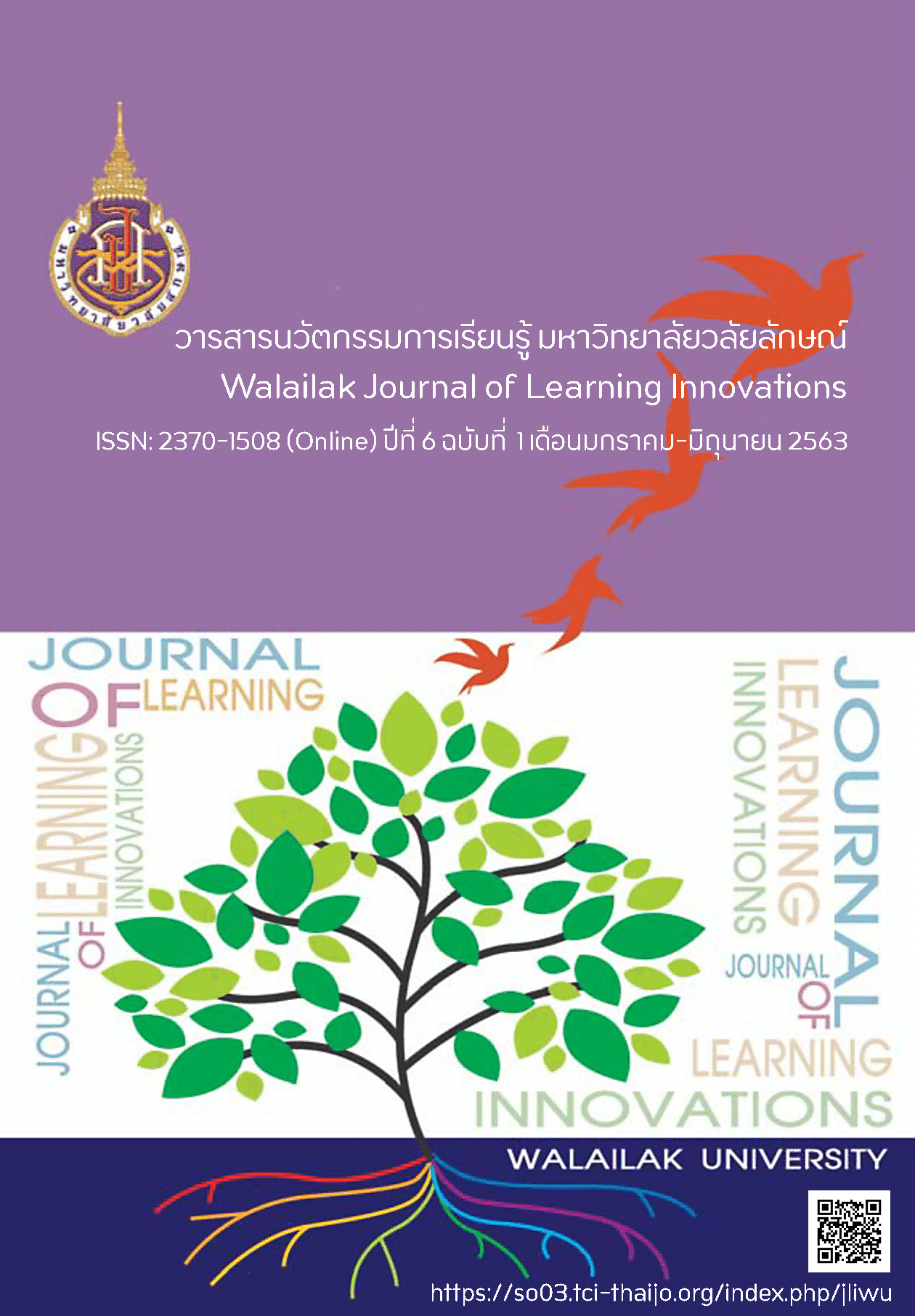The Views of Thai Preservice Teachers to a Flipped Classroom Approach towards Teaching a Special Education Course
DOI:
https://doi.org/10.14456/jli.2020.6Keywords:
Flipped Classroom Approach, Thailand, Preservice Teachers, Special EducationAbstract
A flipped classroom approach (FCA) has been introduced to assist students in increasing their knowledge and necessary learning skills, including higher order thinking skills. This study aimed to develop a FCA in a special education course for undergraduate students and investigate their learning experiences and satisfactions towards this teaching approach. Fifteen preservice teachers participated in a flipped classroom based course for 14 weeks. The data from a questionnaire and a focus group interview were collected and both the quantitative and qualitative data were analyzed. The participants reported that they were satisfied in learning in this course. They were able to prepare themselves for the lessons before class, which led them to understand the lesson in class much more easily as well as giving them the ability to review the lesson at their own pace. However, the students reported that the drawbacks of this approach were the time management issue, the lack of instant interaction during the lecture and technical issues with internet access. The implementation, limitation and suggestions of this FCA are discussed.
References
Akçayır, G., & Akçayır, M. (2018). The flipped classroom: A review of its advantages and challenges. Computers & Education, 126, 334-345.
Bates, S., & Galloway, R. (2012). The inverted classroom in a large enrolment introductory physics course: a case study: The Higher Education Academy.
Bergmann, J., & Sams, A. (2012). Flip your classroom: Reach every student in every class every day. Washington, DC: International Society for Technology in Education.
Bishop, J. L., & Verleger, M. A. (2013, June 23-26). The flipped classroom: A survey of research. Paper presented at the 120th American Society of Engineering Education Annual Conference & Exposition, Atlanta, Georgia, United States.
Blair, M. N. (2012). Technology integration for the new 21st century learner. Principal, 91(3), 8-13.
Bohaty, B. S., Redford, G. J., & Gadbury-Amyot, C. C. (2016). Flipping the classroom: assessment of strategies to promote student-centered, self-directed learning in a dental school course in pediatric dentistry. Journal of dental education, 80(11), 1319-1327.
Butt, A. (2014). Student views on the use of a flipped classroom approach: Evidence from Australia. Business Education and Accreditation, 6(1), 33-43.
Eichler, J. F., & Peeples, J. (2016). Flipped classroom modules for large enrollment general chemistry courses: a low barrier approach to increase active learning and improve student grades. Chemistry Education Research and Practice, 17(1), 197-208.
Enfield, J. (2013). Looking at the Impact of the Flipped Classroom Model of Instruction on Undergraduate Multimedia Students at CSUN. TechTrends, 57(6), 14-27. doi:10.1007/s11528-013-0698-1
Fulton, K. (2012). Upside down and inside out: Flip your classroom to improve student learning. Learning & Leading with Technology, 39(8), 12-17.
Hennink, M., Hutter, I., & Bailey, A. (2011). Qualitative research methods. London: SAGE Publications.
Herreid, C. F., & Schiller, N. A. (2013). Case studies and the flipped classroom. Journal of College Science Teaching, 42, 62-66.
Jaster, R. W. (2013). Inverting the classroom in college algebra: An examination of student perceptions and engagement and their effects on grade outcomes. (Doctoral dissertation), Texas State University-San Marcos.
Kay, R., & Kletskin, I. (2012). Evaluating the use of problem-based video podcasts to teach mathematics in higher education. Computer Education, 59(9), 619-627.
Kim, M. K., Kim, S. M., Khera, O., & Getman, J. (2014). The experience of three flipped classrooms in an uran university; an exploration of design principles. Internet and Higher Education, 22, 37-50.
Kupongsak, N. (2017). Learning Achievement On Thai Language For Creativity And Learners’ Satisfaction Towards The Flipped Classroom Method. Journal of Graduate Studies Valaya Alongkorn Rajabhat University, 11(1),56-66.
McLaughlin, J. E., Roth, M. T., Glatt, D. M., Gharkholonarehe, N., Davidson, C. A., Griffin, L. M., . . . Mumper, R. J. (2014). The flipped classroom: A course redesign to foster learning and engagement in a health professions school. Academic Medicine, 89(2), 1-8. doi:10.1097IACM.0000000000000086
Raktham, C. (2008). Cultures and learner behaviours: A qualitative investigation in a Thai classroom. (Doctoral dissertation), University of Warwick.
Roehl, A., Reddy, S. L., & Shannon, G. J. (2013). The flipped classrooms: An opportunity to engage millennial students through active learning strategies. Journal of Family and Consumer Sciences, 105(2), 44-49.
Sattrapruek. S. (2017). Flipped Classroom in 21st Century Learning for Development of Learning and Innovation Skills. Academic Services Journal Prince of Songkla University, 28(1), 100-108.
Seubsom, K., & Mheeplad, N. (2017). The Development of a Flipped classroom with the Integration of Multimedia Classroom Teaching through Google Classroom. APHEIT Journal, 6(2), 118-127.
Triantafyllou, E., & Timcenko, O. (2014). Introducing a Flipped Classroom for a Statistics Course: a Case Study. Paper presented at the Proceedings of the 25th International Conference on European Association for Education in Electrical and Information Engineering.
Vaughan, M. (2014). Flipping the learning: An investigation into the use of the flipped classroom model in an introductory teaching course. Educational Research and Perspectives, 41, 25-41.
Downloads
Published
How to Cite
Issue
Section
License
เนื้อหาและข้อมูลในบทความที่ลงตีพิมพ์ในวารสารนวัตกรรมการเรียนรู้ มหาวิทยาลัยวลัยลักษณ์ ถือเป็นข้อคิดเห็นและความรับผิดชอบของผู้เขียนบทความโดยตรง ซึ่งกองบรรณาธิการวารสาร ไม่จำเป็นต้องเห็นด้วย หรือร่วมรับผิดชอบใดๆ
บทความ ข้อมูล เนื้อหา รูปภาพ ฯลฯ ที่ได้รับการตีพิมพ์ในวารสารนวัตกรรมการเรียนรู้ มหาวิทยาลัยวลัยลักษณ์ ถือเป็นลิขสิทธิ์ของวารสารนวัตกรรมการเรียนรุ้ มหาวิทยาลัยวลัยลักษณ์ หากบุคคลหรือหน่วยงานใดต้องการนำทั้งหมดหรือส่วนหนึ่งส่วนใดไปเผยแพร่ต่อเพื่อกระทำการใดๆ จ้อต้องได้รับอนุญาตเป็นลายลักษณ์อักษรจากวารสารนวัตกรรมการเรียนรู้ มหาวิทยาลัยวลัยลักษณ์ก่อนเท่านั้น

